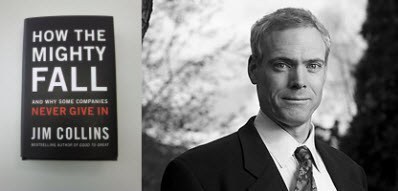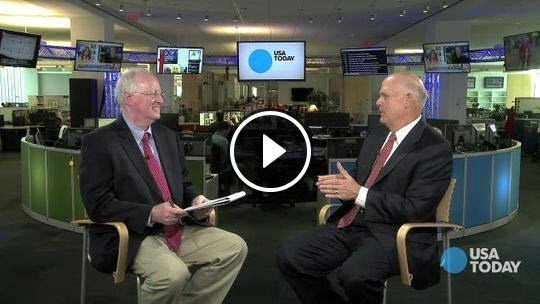Lee Ellis's Blog, page 346
August 22, 2013
The Latest Recommendation from Lee’s Bookshelf – “How the Mighty Fall” by Jim Collins.
Lee’s latest recommendation from his bookshelf is How the Mighty Fall by Jim Collins. Not only is it a valuable personal read, but it has also helped Lee in his consulting practice with the organizations that he serves. Have you read this book? If so, please share—here’s a brief excerpt:
“Every institution, no matter how great, is vulnerable to decline. There is no law of nature that the most powerful will inevitably remain at the top. Anyone can fall and most eventually do. But, as Collins’ research emphasizes, some companies do indeed recover—in some cases, coming back even stronger. How did they do it?”
Here’s a great archive article from Jim’s website on the topic – click here
Here’s more information about the book – click here


August 21, 2013
Wounded Warriors® Feature – “Lessons from Vietnam for Today’s Warrior”
 Lee offers advice and insight from his Vietnam POW experience to the 400,000+ wounded warriors that are dealing with the after effects of combat.
Lee offers advice and insight from his Vietnam POW experience to the 400,000+ wounded warriors that are dealing with the after effects of combat.
After a life-changing experience, what does it take to be resilient and bounce back? How do the principles of character and courage help one through a life or work challenge?
Read Lee’s article in The After Action Report, the Wounded Warriors Organization’s official publication, and please share it with others!
Download the article here (Page 16)


August 20, 2013
What If Leaders Have Different Sets of Values? Does it Make Any Difference? Listen to This Interview
Leadership consultant and author, Lee Ellis, visited with Gov. Mike Huckabee on his radio show yesterday, and they had some honest discussion about life and leadership.
In the interview, Lee shares the top lessons that he learned through his POW experience as well as current topics such as the mayor of San Diego and the New York City mayor’s race. The argument by some people is that people have different values, so there isn’t a standard set of values that we all must follow in society to be good leaders.
Hear Lee’s instant answer on this topic, and please add your comments below to their discussion!
Related Articles:
Breaking Story – “How Emory University Failed Its Own Honor Code”
Knowing Yourself and the Power of Belief


August 19, 2013
Acceptance speech by actor Ashton Kutcher — Hear his Surprising Message
Regardless of your perception of actor Ashton Kutcher, we had to share his recent speech at the 2013 Teen Choice Awards regarding his perspective on life and work. You may be surprised.
What part of his message makes you want to cheer?
Related Articles:
Leaders Dig Deep and Treasure Their Trials: A How-To Article


August 15, 2013
How to Be a Thought Leader–It’s Easier Than You Think
By Dorothy Crenshaw
Becoming a thought leader—everyone’s always talking about it, but who’s really doing it? It’s a cliché in PR and marketing circles. We tend to promise clients we can help make them a thought leader, pepper our proposals with the term, and invoke “thought capital” to differentiate corporations and their most marketable attributes.
So what is thought leadership? How can one achieve it?
While it’s not as easy as it sounds, thought leadership status is more attainable. In my book, it’s not just about visibility or strong expertise although both are highly desirable. True thought leadership requires a blend of innovation, insight, and influence. The easiest way to achieve that status, of course, is to be first. A handful of early bloggers, like Chris Brogan or Mack Collier, were able to parlay their status and insight into enduring influence, helping marketers and communicators interpret and anticipate change. As a company, Amazon.com is a good example of a thought leader, given its early bet on the impact of e-commerce, and, later, web services, at a time when many doubted the wisdom of the investment. But most of us haven’t had the luck to have been in the right place at the right time and the presence to have realized it.
So, in the spirit of thought leadership about, well, thought leadership, here’s my list of essential behaviors and qualities common to past and current people and brands that fit the bill.
Six Essential Thought Leader Behaviors -
They’re about ideas. PR educator Bill Sledzik points out that John F. Kennedy was a thought leader when he rallied Americans to put a man on the moon before 1970. It wasn’t a new concept, but it captured the public imagination like few others, and it served as a metaphor for American ingenuity, competitiveness, and idealism.
They have focus. “Go vertical or go home,” is how author Daniel Ramus puts it. It’s far easier to stand out and thwart imitators if the field of expertise is narrow or niche. So while it’s a challenge to be recognized as a thought leader in marketing, it may be more feasible to earn the label based on expertise in new forms of marketing segmentation or online behavioral marketing.
They package the message. Often an idea or trend is staring us in the face, but he who identifies and names it can take the credit. Malcolm Gladwell had some excellent and insightful observations about the spread of ideas and memes, but it was only after he packaged his observations under a label borrowed from epidemiology that “the tipping point” was born.
They take risks. Many true thought leaders are naturally contrarian. If it’s legitimate, one of the quickest routes to recognition is to zig when others zag. The quintessential example here, of course, is Steve Jobs. He was never afraid to swim upstream, and he took risks in rejecting market research and other conventions of product development.
They offer hope. Part of inspiration is to offer a path to progress, particularly in a dynamic, troubled, or rapidly changing industry. Andrew Zolli elevated his own brand from “foresight expert” to true thought leader with his book, Resilience: Why Things Bounce Back, not because the book was well received but due to the hopeful call-to-action and insights for a cynical audience saturated with dire prophesies about the fate of the natural environment.
They take the long view. Laura Ramos of Forrester says it well when she writes about the “authentic generosity” necessary for B2B thought leadership. It’s almost never about profiting from ideas in the short term; rather, it comes from a deep understanding of the problems of customers or colleagues, and it takes patience. They literally give it away, but the fruits of true thought leadership include more and deeper relationships with customers, which is a key ingredient for business health and growth. DC
Dorothy Crenshaw is a guest blogger on Business 2 Community. The original post to this article is published here – http://bit.ly/14HG2x4
Related Articles:
How to Avoid Two Dangerous Traps in Leadership—Listen and Engage
Take a Risk – Help Someone Else


August 14, 2013
The Leadership Quality of Humor During Challenging Times – Watch This Interview
In this latest 3-minute interview, author and speaker, Col. Lee Ellis USAF (Ret), talks about a funny moment during his Vietnam POW experience, as well as the overall importance of having a good sense of humor in challenging times. This story and others are shared in his latest book entitled ‘Leading with Honor’.
How has a good sense of humor helped you as a leader in the past? Please share your comments and stories!
Related Videos:
Can Over-Communication Be Taken Too Far?
What’s So Critical About a Support Team in Leadership?


August 13, 2013
Washington Needs a Real Shot of Courage—A Call to Action Editorial
Read Lee’s bold editorial on TheHill.com as he encourages leaders in Washington D.C. to be courageous leaders. Do you believe it’s possible for courageous leaders to emerge out of the mire of our political system? What does it take, and who’s doing it well?
And if you believe that this is an important message, would you do us a favor and visit the site and post a comment to raise the visibility of this message on The Hill website – thank you!


August 12, 2013
GM CEO, Dan Akerson’s Top 9 Leadership Lessons – Innovation and Focus in a Complex Environment
In 2008, General Motors faced bankruptcy until the U.S. Government bailed them out. In the last 5 years, we’ve seen GM steadily begin to turn the ship around, become profitable again; launch new, more innovative products; and remove some layers within their organization.
In these short video interviews with the newest GM CEO Dan Akerson, he gives insight into his leadership philosophy as a non-car guy in a very complex, reactionary organization like GM.
What’s the best principle you received in these interviews? Please watch and share your thoughts.
Related Articles:
Leaders and Difficult Decisions: How to Handle Syrian Crisis Scenarios – Read More
Discovering the Latest Innovation in Leadership—What’s the Newest Crank? – Read More


August 5, 2013
What’s the Best Leadership Choice in Your Upcoming City or Regional Elections This Fall? Your Free Evaluation Resource

This free, 4-page guide helps evaluate political candidates beyond their position on the issues.
There are dozens of city and state political elections over the next four months, and we want you to be prepared on how to vote for your local public servants. What’s more important—character, courage, or competence? When both candidates seem technically qualified, what’s the deciding factor?
To help, we invite you to download and share the FREE “Leading with Honor Voter’s Guide” to evaluate the best leaders in life, work, and community. Learn more at www.FreedomStarMedia.com/Vote
Related Articles:
Leaders and Difficult Decision: How Do You Handle Syrian Crisis Scenarios?
On Leaders and Accountability (Part 6): How to Take Actions When Expectations Aren’t Met


August 1, 2013
How to Avoid Two Dangerous Traps in Leadership—Listen and Engage
We often read or hear in the media about leaders whose lack of courage reaped painful consequences. But these “spectacular” failures are just the tip of the iceberg. Doubts and fears of a much smaller magnitude have caused legions of leaders to fail in less obvious ways. Although these failures don’t make the newspapers, they nevertheless can suck the energy and life out of the people and organizations they affect. By learning to listen and engage in a healthy way, I believe that many of these less-obvious failures could be avoided.
Learn to Listen
Many leaders fail to listen to the ideas, opinions, and constructive feedback of others. Some go so far as to use intimidation to silence “threatening” ideas. Still others suppress ideas by dominating conversations and not allowing others to speak. These leaders may appear “macho” on the outside, but in reality their fears and insecurities send a loud message that they don’t want anyone to disagree with their view of the world. Unfortunately, most of us know how exhausting and demoralizing it can be to work for a leader whose tender ego must be carefully guarded. Usually there is a graveyard outside this executive’s office that’s filled with the bodies of messengers who had the courage to provide honest feedback.
“Usually there is a graveyard outside this executive’s office that’s filled with the bodies of messengers who had the courage to provide honest feedback.”
If you suspect that you are this type of person, let me encourage you to get a “leadership 360 assessment,” so your direct reports, peers, and manager (or board of directors) can give you candid, anonymous feedback. (Now, that will take some real courage on everyone’s part, won’t it!) If the results indicate a problem, don’t rationalize your behaviors or demonize the messengers. Engage the issues and grow into the leader you can be, the one that your followers deserve.
When the truth is courageously communicated, people and organizations flourish. But when doubts and fears hold sway, leaders avoid hard decisions and responsible actions, and instead look for a comfortable way out. At best, team energy drains away and people don’t grow. Too often, fear and doubt cause bad judgment that derails the leader’s influence.
The Leadership Engagement Model
Leaders who lack courage to engage problems usually veer off course in one of two directions: they will either seek to dominate, or they will seek to withdraw (fight or flight; violence or silence.) Both of these counterproductive behaviors have the same root cause: fears and doubts. I’ve found the Leadership Engagement Model™ depicted below to be extremely helpful for improving the cooperation and productivity of teams working cross-functionally, especially if a “silo mentality” is prevalent. It has also been beneficial for strategic partners who have competing interests.

Get a free Courage Challenge pocket card with this helpful table–go to http://www.FreedomStarMedia.com/Courage
For example, in most medical communities a natural tension exists between the hospital and the physicians and clinics that use the hospital. Typically, one party tries to dominate to get its way, which in turn causes the other party to become distrustful and combative.
“Meaningful engagement occurs when each party fights for its ideas in a healthy, constructive way, while still being open to the ideas of others. This type of dialog is evidence of humility, courage, and confidence.”
Eventually, emotions can get so raw that one party withdraws, or they both do. To halt this vicious cycle, the two sides need to courageously commit to engage in productive dialog, identify common goals, and implement agreed-upon solutions. Meaningful engagement occurs when each party fights for its ideas in a healthy, constructive way, while still being open to the ideas of others. This type of dialog is evidence of humility, courage, and confidence. Doubts and fears are normal. You can’t avoid them, but you can manage them. You can choose to override your feelings and do the right thing. You can choose to lean into the pain for the good of others and yourself. Like the men in the POW camps you’ve read about, you can choose to be a strong leader by being courageous.
In what specific situations might you be dominating or withdrawing (e.g., by attacking or procrastinating) when you should be engaging? What choices do you need to make to engage issues you have been avoiding? Please share your wisdom and experiences in this forum.
LE
Special Offer! Get a FREE Courage Challenge pocket card that will help you effectively engage as a leader. Learn More
Related Articles:
Lee Shares Inspirational Thoughts about Leadership Fears and Courage
—-
As president of Leadership Freedom® LLC, a leadership and team development consulting and coaching company, Lee Ellis consults with Fortune 500 senior executives in the areas of hiring, teambuilding, human performance, and succession planning. His media appearances include interviews on networks such as CNN, ABC World News, and Fox News Channel. His latest award-winning book about his Vietnam POW experience is entitled Leading with Honor: Leadership Lessons from the Hanoi Hilton. Learn more at www.leadingwithhonor.com.










